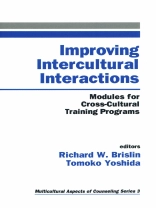As the editors of this volume point out, one certainty in life is that people must interact with others from very different cultural backgrounds–whether or not they are prepared to do so. The modules in this volume encourage productive and effective intercultural interactions in business, educational, social, and health services settings. Each module–a collection of materials for cross-cultural training programs–has a similar structure. They all have a combination of experiential exercises, self-assessment instruments, traditional ‘text’ material describing concepts and the research methods necessary in using a given module, and case studies and/or critical incidents. Among the subjects Improving Intercultural Interactions addresses are gender relations in the workplace, intercultural education at the university level, intercultural communication for health care professionals, multicultural counseling, and nonverbal behavior in intercultural interaction. Improving Intercultural Interactions is a valuable resource for consultants, counselors, personnel officers, and others who offer various kinds of cross-cultural training programs. It is also useful as a supplemental text in graduate and undergraduate courses dealing with culture and behavior. ‘The present volume . . . aims at supplying not only valuable ideas and ideals but most of all practical guidelines to all those interested in carrying out satisfactory training programs.’ –Language, Culture, and Curriculum ‘An excellent practical guide to intercultural sensitivity, in the business world; elementary, secondary, and tertiary level schools; and social service and health delivery agencies. Each chapter provides opportunities for self-assessment, cases, critical incidents, constructs that can develop skills in analyzing intercultural situations, opportunities to practice these skills, and field exercises to test the newly acquired sensitivity. It increases awareness of culture and cultural differences, provides facts that can help adjustment, suggests ways to feel appropriately for interaction with members of other cultures, and opportunities to identify and practice skills that can assist in adjustment to other cultures.’ –Harry C. Triandis, University of Illinois ‘Improving Intercultural Interactions represents the next step forward in resource books for trainers, teachers, professors, organizational developers and the like who are in constant need of upgrading the results of their cross-cultural training programs. . . . It presents sequences of training processes from self-assessment and critical incidents through the development of an understanding of cultural concepts and frameworks to exercises targeted to cause the learner to experience and practice an array of behaviors or actions in appropriate cross-cultural problem situations. The fact that each of the books′ modules ends with suggested actions based on specific examples helps lead the learner to a position where he or she can develop personally and culturally relevant strategies for their workplace situation. This book will serve as a resource for persons in culturally diverse work situations, whether it be business, education, health, or a broad array of other public and private organizations.’ –Sheldon Varney, University of Hawaii at Manoa
Table des matières
The Content of Cross-Cultural Training – Richard W Brislin and Tomoko Yoshida
An Introduction
PART ONE: THE WORLD OF BUSINESS
Working Cooperatively with People from Different Cultures – Richard W Brislin
Cross-Cultural Training for the Global Executive – Neal R Goodman
Gender Relations in the Workplace – Elaine K Bailey
Using Approaches from the Field of Cross-Cultural Training
Individualism and Collectivism as the Source of Many Specific Cultural Differences – Richard W Brislin
PART TWO: EDUCATION
Cross-Cultural Training for Adolescents and Professionals Who Work with Youth Exchange Programs – Kenneth Cushner
Preparing Teachers for an Intercultural Context – Kenneth Cushner
Intercultural Education at the University Level – Neal R Goodman
Teacher-Student Interaction
International Students and International Student Advisers – Paul Pedersen
PART THREE: SOCIAL AND HEALTH SERVICES
Intercultural Communication for Health Care Professionals – Colleen Mullavey-O′Byrne
Intercultural Interactions in Welfare Work – Colleen Mullavey-O′Byrne
Multicultural Counseling – Paul Pedersen
PART FOUR: COMMUNICATION ACROSS CULTURAL BOUNDARIES
Interpersonal versus Noninterpersonal Reality – Tomoko Yoshida
An Effective Tool Individualists Can Use to Better Understand Collectivists
Nonverbal Behavior in Intercultural Interaction – Ted Singelis
Approaching Cultural Crossover in Language Learning – Mark Sawyer and Larry E Smith
Training Bilinguals to Interpret in the Community – Carolina Freimanis
A propos de l’auteur
Richard Breslin′s current research focuses on mentoring, cross-cultural training materials and the experiences of business people on overseas assignments. Brislin reviews submissions for over ten professional journals and five major textbook publishers. He develops materials for use in cross-cultural training programs and is the author of a text in cross-cultural psychology. One of his books, ‘The Art of Getting Things Done: A Practical Guide to the Use of Power, ‘ was a Book of the Month Club selection in 1992. His most recent publication is Intercultural Interactions: A Practical Guide, ‘ published by SAGE Publications.












